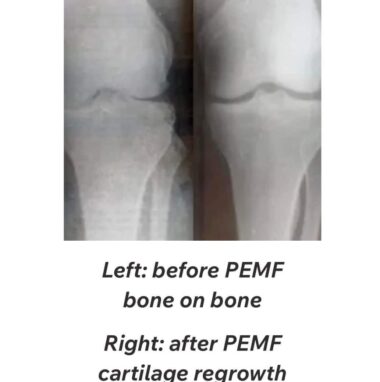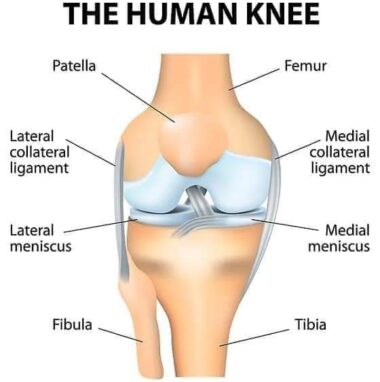Regeneration of Bone on Bone



▶️Cartilage Regrowth with PEMF
The use of PEMF is critical in accelerating cartilage repair. PEMF energizes the chondrocyte cells which produce the cartilaginous matrix thus speeding up the production of cartilage. Therefore, the stimulation of these cells produces new cartilage where previously it was damaged or worn out. At the same time the osteoclasts break down bone structure that has been damaged, worn out, or weakened, while the osteoblasts are stimulated to regenerate new bone structure.Understanding how cartilage works helps understand how PEMF helps.
▶️PEMF Stimulates Cartilage Regrowth
Cartilage is dense and does not contain blood vessels or nerves, and therefore is rebuilt very slowly and is not easy to repair.
▶️What is Cartilage?
Articular Cartilage
Where bones come together they are covered in a flexible smooth white tissue to help form the joints. This connective tissue is called articular cartilage. The smooth cartilage in the joints allows the bones to slide over one another without any friction, making it easier to move.
There are three types of cartilage, elastic cartilage (found in the outer ear, Eustachian tube and epiglottis), hyaline cartilage (found on knee, hip, elbow, shoulder joint surfaces), and fibro cartilage (found in the pubic bone, the intervertebral discs, the knee joints or meniscus, and the jaw or temporomandibular joint). Cartilage is not as rigid as bone mass, but is also not as flexible as muscle.
▶️The Extracellular Matrix
Cartilage is made out of cells called chondrocytes which function as the factories for the molecules that provide structural and biochemical support for the surrounding cells (called the collagenous extracellular matrix).
These factories produce the fibrous proteins which make up collagen, (the protein in the human body that is responsible for most of the bone matrix protein content), elastins, (the proteins that give elasticity to tissues such as blood vessels, lungs, skin, ligaments), and fibronectin, (the glycoproteins that connect cells with collagens to help repair tissue during wound healing).
The lubricant between joints is combination of synovial fluid (secreted by the fibroblasts), and lubricin, (created by factories within the extracellular matrix called fibroblast-like synoviocytes). Cartilage is dense and does not contain blood vessels or nerves, and therefore is rebuilt very slowly and is not easy to repair.
▶️Tendons and Ligaments.
Tendons connect bone to muscles. Similar to cartilage are the tendons which are built from collagen fibres, and are formed in parallel arrays closely packed together. Ligaments connect bones to bones. Ligaments are also formed from collagenous fibres, banded together in dense regular connective tissue bundles.
▶️Cartilage Damage and Disease
Diseases that affect the cartilage.
Osteoarthritis results in the cartilage which covers the bone, (the articular cartilage), slowly thins and wears away. This results in a bone upon bone situation which can be extremely painful and reduces the ability to move. Osteoarthritis can often be the result of high stress to a joint due to a specific activity. Traditionally, osteoarthritis eventually is treated by surgery and the introduction of implants (replacement synthetic joints). Replacement joints are never as strong as natural ones.
A detached or ruptured knee can result when the knee is either detached, or the disc in between the two bones (articular disk) is ruptured causing a leakage of the lubricating synovial fluid and resulting in a bone on bone situation, which is extremely painful and adversely affects the ability to move.
Bursitis occurs when the pouches or sacs of synovial fluid, (called bursae) surrounding the knee, elbow or shoulder joint become inflamed. This is sometimes referred to as housemaid’s knee, and tennis elbow.
Torn cartilage occurs when the meniscus, (the two cartilage tissues that provide structural integrity to the knee when it undergoes tension and torsion), can also be damaged. The meniscus on the outside of the knee is the lateral (outer) meniscus, the meniscus on the inside of the knee is medial (inside) meniscus.
Costochondritis is the inflammation of cartilage in the ribs which can cause chest pain (medical conditions with “itis” at the end refer to inflammation).
Spinal Disc Herniation occurs when the discs between the vertebrae are ruptured causing the fluid to leak out (herniate). This fluid has the consistency of toothpaste. This often causes compression of the nerves and results in severe back pain (depicted right). Depending on where along the spine the rupture occurs it can cause numbness in the arms, sciatica, bladder issues and a host of complications.
▶️Slow Cartilage Repair
Cartilage is difficult to repair. Cartilage is manufactured by cells called chondrocytes which produce and maintain the cartilaginous matrix. The repair cells are located within small spaces within the cartilage called the lacuna and cannot move to damaged areas. Cartilage in knees, hips, elbows etc, (called the hyaline cartilage), does not have a good blood supply (low vascular areas). It takes a long time to lay down new cartilaginous matrix, so it is usually replaced by fibrocartilage scar tissue.
▶️Using PEMF to Accelerate Cartilage Repair
Regrown Cartilage in the Knee
Patients have experienced regrowth of cartilage in knee joints changing the bone-on-bone situation, recreating the cartilage between the bones increasing the glide and removing the pain. The X-ray below shows the knee of a 70-year-old female who was experiencing extreme pain when walking because the cartilage had degenerated. PEMF therapy encouraged cartilage growth between the bones (on right) removing the need for a knee replacement.
▶️Avoiding Hip Replacement
A common feature of middle to old age is the degeneration of the hip joint. The bone structure is diminished due to a drop in bone density from osteoporosis. The cartilage gets worn out as the structure collapses resulting in bone on bone. Usually the treatment is hip replacement, however this is often not prescribed for those experiencing hip degeneration at an early age.
PEMF stimulates both bone and cartilage regeneration, helping to avoid hip replacements. The X-ray shows the regeneration of a hip in a middle aged woman, removing the need for the hip replacement on this hip. PEMF has consistently resulted in cartilage and bone regrowth, repairing knees and hips and removing the need for invasive surgery with the potential for nerve damage, infections and a much longer recovery time.
▶️Scientific studies.
Scientists and researchers around the world have been finding significant results with the use of PEMF in cartilage regrowth and bone repair.
The department of Orthopaedics from the Christin Medical College and the Sree Chitra Tirunal Institute for Medical Sciences and Technology in India reported:
“PEMF stimulation of osteochondral defects with calcium phosphate scaffold is effective in hyaline cartilage formation. PEMF is a non-invasive and cost effective adjuvant treatment with salvage procedures such as abrasion chondroplasty and subchondral drilling.”
The Department of Biochemistry and Biophysics at the University of Rhode Island produced a report which stated:
Pulsed electromagnetic fields (PEMFs) of certain configuration have been shown to be effective clinically in promoting the healing of fracture nonunions and are believed to enhance calcification of extracellular matrix. In vitro studies have suggested that PEMFs may also have the effect of modifying the extracellular matrix by promoting the synthesis of matrix molecules…. Histomorphometric studies indicate that the maturation of bone trabeculae is also promoted by PEMF stimulation. These results indicate that a specific PEMF can change the composition of cartilage extracellular matrix in vivo and raises the possibility that the effects on other processes of endochondral ossification (e.g., fracture healing and growth plates) may occur through a similar mechanism.”(2)
Conclusions from a study conducted by the University of Ottawa stated:
“Current evidence suggests that electrical stimulation therapy may provide significant improvements for knee osteoarthritis…” (3)
The Royal Veterinary Basic College in London also reported:
“The influence of pulsed electromagnetic fields (PEMF) on proteoglycan composition in cartilage extracellular matrix has been investigated…. PEMF treatment… significantly stimulated the retention of glycosaminoglycans in the explants and reduced the release of glycosaminoglycans into the media… It is concluded that PEMF treatment preserved extracellular matrix integrity of cultured cartilage explants by down-regulating proteoglycan synthesis and degradation in a co-ordinated manner without affecting their gross structural nature.
▶️Building Blocks
PEMF will stimulate the osteoblasts and the extracellular matrix in rebuilding bone structure and cartilage.
PEMF invigorates the different cells involved in the rebuilding of cartilage. The whole process is like a building site, where the construction workers are motivated and ready to go. However, they need the building materials for construction to begin.
⏯️Good nutrition, minerals, and supplementation are required to provide the building blocks for the cells to work in reconstruction. Due to soil depletion, healthy diets may not contain the necessary nutrients in the adequate amounts to make a difference.
